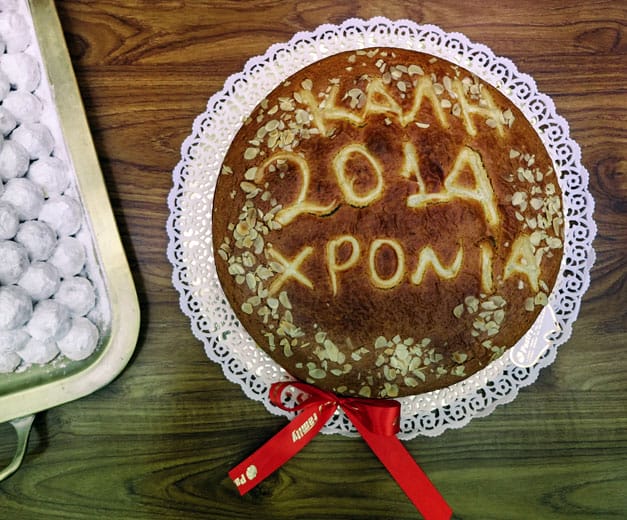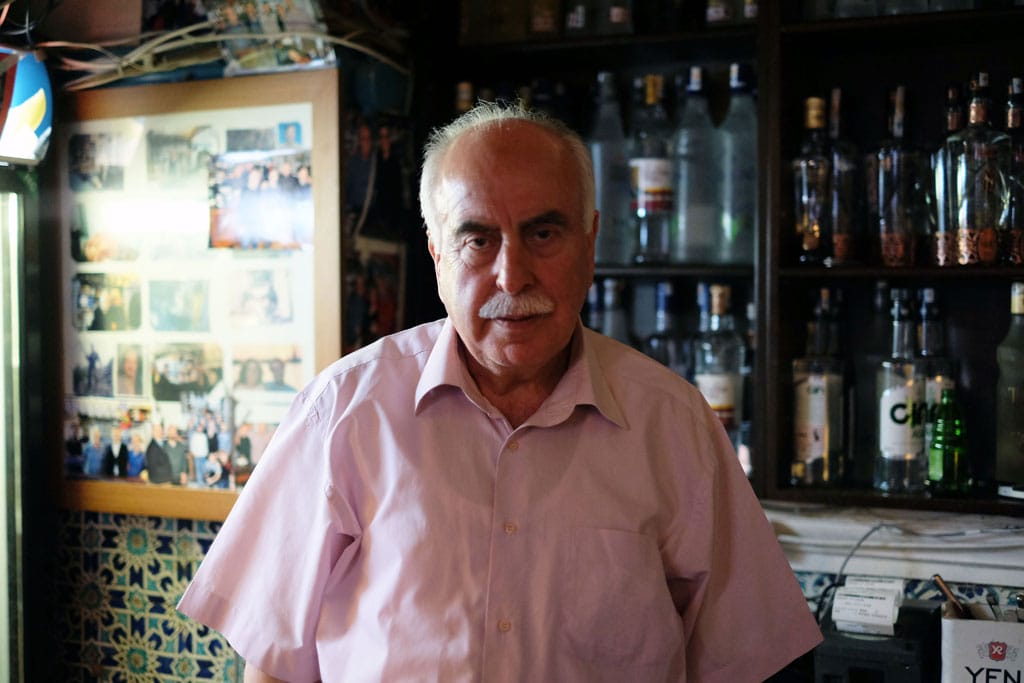Just after the stroke of midnight on New Year’s Eve or on the first day of the New Year, many Greek Orthodox families gather around the table to cut and split the vasilopita, a cake named after St. Basil (Aghios Vasilios), the Greek Santa Claus. The head of the family “crucifies” the cake three times with a knife and then cuts it into triangular pieces. Usually, the first piece is offered to Christ, the second to the Virgin Mary, the third to St. Basil and the fourth to the “house” before family members and friends each receive one. Some may offer a slice to St. Nicholas, the patron of sailors, to the poor, as St. Basil cared for them, or to the family shop or company. The custom of dividing the vasilopita is performed at many events throughout January and even into early February among many associations, agencies and other organizations. Each person wishes the others chronia polla (“many years”) and “Happy New Year” to bless the house and to bring good luck.
A vasilopita usually contains a fluri, or lucky coin, which is placed in the dough before baking. These days, the fluri is a common coin, but once upon a time it was a gold or silver piece. Whoever finds the coin in his or her slice is said to be particularly blessed and will supposedly be lucky for the next year (and thus keeps it for the duration). If the coin goes to Christ it means that the whole family will be protected, while if it goes to the house, it is a blessing for the entire household. Vasilopita has its roots in ancient Greco-Roman traditions, such as Saturnalia (the feast of the god Cronus, worshiped in Greece) and the Roman Saturnalia, where, in similar fashion, coins were tucked into sweets and pies for lucky recipients.
Legend also has it that when St. Basil was the bishop of Caesarea in Cappadocia, Asia Minor, the Eparch of Cappadocia came to plunder the town. St. Basil asked the villagers to collect their jewelry and coins to provide a ransom to the conqueror and to dissuade him from looting the area. However, the Eparch backed down either because he regretted the action or because Saint Mercurius and a host of angels miraculously dismissed his army. But when it came time to return the valuables, St. Basil, not knowing who owned what, instructed the villagers to prepare small loaves. He placed one of the coins or valuables into each and distributed the loaves to the whole town on the day of church worship.
 There are two kinds of traditional vasilopita: a fluffy, yeasted sweet brioche called politiki vasilopita (from Poli or Constantinople, now known as Istanbul) and a classic cake. Both are prepared mainly from flour, eggs, sugar and milk, but across Greece, variations abound, with loaves studded with nuts and dried fruit, savory versions that resemble cheese or leek pies in West Macedonia or even modern recipes with chocolate. They may be left plain, dusted with sugar or sesame or decorated with the year written with rows of almonds or with white icing.
There are two kinds of traditional vasilopita: a fluffy, yeasted sweet brioche called politiki vasilopita (from Poli or Constantinople, now known as Istanbul) and a classic cake. Both are prepared mainly from flour, eggs, sugar and milk, but across Greece, variations abound, with loaves studded with nuts and dried fruit, savory versions that resemble cheese or leek pies in West Macedonia or even modern recipes with chocolate. They may be left plain, dusted with sugar or sesame or decorated with the year written with rows of almonds or with white icing.
Our favorite politiki vasilopita can be found at Toula in Pagrati. When we step into the tiny shop, the alluring scents of fresh goat butter and the spices mahlepi (made from the seeds of a kind of cherry) and mastic (made from the resin of the lentisk tree) take our breath away. We also love the vasilopita at Takis bakery in Koukaki; the loaf has a wonderfully well-developed flavor and is perfect with a glass of milk before bedtime. Further north, Divan of Palaio Faliro in Phaleron makes an authentic politiki sprinkled with sesame seeds. If we find ourselves on the other side of Athens, we head to Varsos in Kifisia. The wait is long but worth it.
For the cake version, Pastry Family has for 45 years prepared the same superb recipe, redolent with the fragrance of orange and almonds and remarkably moist and rich. When we’re downtown, we seek out the vanilla- and orange-scented version at Aristokratikon, the old Athenian chocolate shop near Syntagma. Whichever version we choose, we always check to make sure it contains a lucky coin. Kali Chronia! Happy New Year!
 February 17, 2020 Cut and Run
February 17, 2020 Cut and Run
Sold by the slice, pizza is emblematic of New York City. It’s an inexpensive antidote to […] Posted in Queens January 22, 2013 Hai Di Lao
January 22, 2013 Hai Di Lao
Good service in China is a relative term, and the longer you live here, the lower your […] Posted in Shanghai June 21, 2016 Behind Bars
June 21, 2016 Behind Bars
In Istanbul's iconic Haydarpaşa train terminal, the door of a crowded restaurant and bar […] Posted in Istanbul
Published on January 01, 2014
Related stories
February 17, 2020
QueensSold by the slice, pizza is emblematic of New York City. It’s an inexpensive antidote to hunger pangs that can be ordered quickly, and eaten quickly, even on the go. Think of Tony Manero, the John Travolta character in Saturday Night Fever, double-decking a pair of slices while strutting through Bay Ridge, Brooklyn. At a…
January 22, 2013
ShanghaiGood service in China is a relative term, and the longer you live here, the lower your expectations sink. The Michelin Guide allegedly won’t deign to cross over the Hong Kong border into China because they refuse to sully their white-tablecloth reputation by doling out stars to restaurants with subpar service. But the inspectors must…
June 21, 2016
IstanbulIn Istanbul's iconic Haydarpaşa train terminal, the door of a crowded restaurant and bar opens to beams of sparkling light streaming across the Marmara Sea coast. Trains haven't departed Haydarpaşa for nearly three years while the station undergoes extensive renovations, but its restaurant, Mythos, is still open and popular as ever, a refuge for a…

















































































